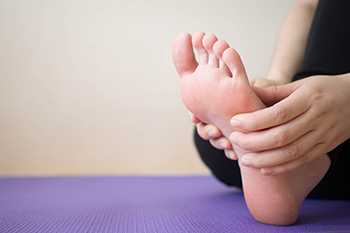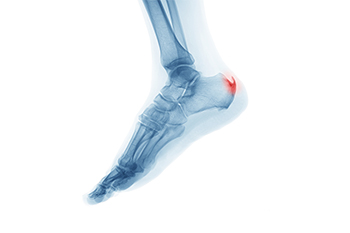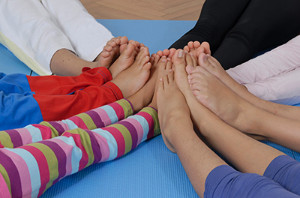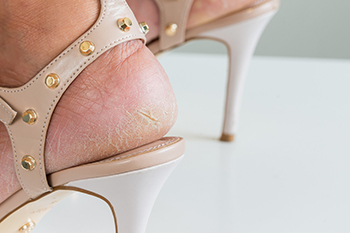Items filtered by date: February 2023
Causes of Pain on the Outer Part of the Foot

Pain on the outer edge of the foot can be debilitating, affecting how you walk or even stand. It can cause instability and keep you from participating in your everyday activities. This type of injury, termed lateral foot pain, can result in stabbing, burning pain, or severe aching. A number of conditions, including ankle sprains, arthritis, or a bunionette can cause lateral foot pain. Ankle sprains, particularly in people with high arches, are thought to be the most common cause of lateral foot pain. In addition, a fifth metatarsal fracture, which connects the pinky toe to the ankle, commonly accompanies an ankle sprain and contributes to the pain. Various forms of arthritis can produce inflammation in any one of the many joints in the feet. A bunion on the small toe is a bone deformity and is often termed a bunionette. Pain is caused when the protruding bone rubs against the inside of the shoe. Among the other causes of lateral foot pain include a dislocation of the cuboid bone, which is located at the outside part of the foot. This injury is common among ballet dancers and other athletes. To find out exactly what is causing the pain on the outside of your foot, it is suggested that you consult a podiatrist.
Foot Pain
Foot pain can be extremely painful and debilitating. If you have a foot pain, consult with Cory Brown, DPM from Cory Brown, DPM. Our doctor will assess your condition and provide you with quality foot and ankle treatment.
Causes
Foot pain is a very broad condition that could be caused by one or more ailments. The most common include:
- Bunions
- Hammertoes
- Plantar Fasciitis
- Bone Spurs
- Corns
- Tarsal Tunnel Syndrome
- Ingrown Toenails
- Arthritis (such as Gout, Rheumatoid, and Osteoarthritis)
- Flat Feet
- Injury (from stress fractures, broken toe, foot, ankle, Achilles tendon ruptures, and sprains)
- And more
Diagnosis
To figure out the cause of foot pain, podiatrists utilize several different methods. This can range from simple visual inspections and sensation tests to X-rays and MRI scans. Prior medical history, family medical history, and any recent physical traumatic events will all be taken into consideration for a proper diagnosis.
Treatment
Treatment depends upon the cause of the foot pain. Whether it is resting, staying off the foot, or having surgery; podiatrists have a number of treatment options available for foot pain.
If you have any questions, please feel free to contact our office located in Lewiston, ID . We offer the newest diagnostic and treatment technologies for all your foot care needs.
It's Time for Beautiful Feet
Stretches May Provide Relief From Heel Spurs

Heel spurs are often uncomfortable, and patients may benefit from performing certain types of stretches and exercises. These may help to lengthen the plantar fascia, which can reduce stress on the heel. Calf stretches can be effective in finding relief from heel spurs. This is done by standing on a step and lowering one heel at a time until a gentle stretch is felt. The foot can be slowly rocked back and forth, which can help loosen the plantar fascia. An additional stretch for plantar fascia is done by sitting on the floor with the affected foot crossed over the opposite knee. This is followed by taking a towel or similar object, wrapping it around the sole of the foot, and stretching the foot towards the body. Heel spurs may be prevented by wearing shoes that fit correctly and by limiting time walking and standing on hard surfaces. If you have a heel spur, it is strongly suggested that you are under the care of a podiatrist who can guide you toward proper treatment and prevention methods.
Heel spurs can be incredibly painful and sometimes may make you unable to participate in physical activities. To get medical care for your heel spurs, contact Cory Brown, DPM from Cory Brown, DPM. Our doctor will do everything possible to treat your condition.
Heels Spurs
Heel spurs are formed by calcium deposits on the back of the foot where the heel is. This can also be caused by small fragments of bone breaking off one section of the foot, attaching onto the back of the foot. Heel spurs can also be bone growth on the back of the foot and may grow in the direction of the arch of the foot.
Older individuals usually suffer from heel spurs and pain sometimes intensifies with age. One of the main condition's spurs are related to is plantar fasciitis.
Pain
The pain associated with spurs is often because of weight placed on the feet. When someone is walking, their entire weight is concentrated on the feet. Bone spurs then have the tendency to affect other bones and tissues around the foot. As the pain continues, the feet will become tender and sensitive over time.
Treatments
There are many ways to treat heel spurs. If one is suffering from heel spurs in conjunction with pain, there are several methods for healing. Medication, surgery, and herbal care are some options.
If you have any questions feel free to contact our office located in Lewiston, ID . We offer the latest in diagnostic and treatment technology to meet your needs.
How to Measure Your Child’s Feet

Finding the right shoes for your child is essential for maintaining the health of their feet as they grow. Experts recommend measuring both feet, as their sizes may differ, and buying shoes that fit the larger foot. An easy way to accomplish this is to have the child stand with their back to the wall and the heels touching the wall. Place a book in front of the longest toe, and measure the distance from heel to toe. The width of the feet is also important to note, so that the toes are not squeezed in their shoes. Be aware that inner soles and stitching may reduce the space inside the shoe. In addition, more space may be required to account for heavier socks if the child is to wear shoes or boots in the colder months. When trying on the shoes, have the child stand on both feet. It is important to leave at least half an inch from the longest toe to the tip of the shoe, as a child’s foot grows rapidly, especially in the early years. Measuring your child’s feet at regular intervals is deemed important to avoid foot deformities and other problems. For more information on proper shoe fitting, please consult a podiatrist.
Making sure that your children maintain good foot health is very important as they grow. If you have any questions, contact Cory Brown, DPM of Cory Brown, DPM. Our doctor can provide the care you need to keep you pain-free and on your feet.
Keeping Children's Feet Healthy
Having healthy feet during childhood can help prevent medical problems later in life, namely in the back and legs. As children grow, their feet require different types of care. Here are some things to consider...
Although babies do not walk yet, it is still very important to take care of their feet.
Avoid putting tight shoes or socks on his or her feet.
Allow the baby to stretch and kick his or her feet to feel comfortable.
As a toddler, kids are now on the move and begin to develop differently. At this age, toddlers are getting a feel for walking, so don’t be alarmed if your toddler is unsteady or ‘walks funny’.
As your child gets older, it is important to teach them how to take care of their feet.
Show them proper hygiene to prevent infections such as fungus.
Be watchful for any pain or injury.
Have all injuries checked by a doctor as soon as possible.
Comfortable, protective shoes should always be worn, especially at play.
If you have any questions please feel free to contact our office located in Lewiston, ID . We offer the newest diagnostic and treatment technologies for all your foot and ankle needs.
Cracked Heels Can Be Treated

Many people notice that they have cracked heels. It can be unsightly, and patients can feel self-conscious while wearing open-back shoes. If the cracks in the skin become severe, they are known as fissures, and may bleed or become infected. This common foot condition can be caused by wearing shoes that have an open back, or from standing on hard surfaces for most of the day. Many people find relief by soaking their feet in warm water, followed by applying a good moisturizer on them. Patients who have medical conditions such as diabetes may be prone to getting cracked heels, and prompt medical attention from a podiatrist is required. People who are obese may have this condition as a result of the added weight the heels must endure. If you have developed this ailment, please speak with a podiatrist who can guide you toward treatment methods, which may include prescribed topical creams.
If the skin on your feet starts to crack, you may want to see a podiatrist to find treatment. If you have any concerns, contact Cory Brown, DPM from Cory Brown, DPM. Our doctor can provide the care you need to keep you pain-free and on your feet.
Cracked Heels
It is important to moisturize your cracked heels in order to prevent pain, bleeding, and infection. The reason cracked heels form is because the skin on the foot is too dry to support the immense pressure placed on them. When the foot expands, the dry skin on the foot begins to split.
Ways to Help Heal Them
- Invest in a good foot cream
- Try Using Petroleum Jelly
- Ease up on Soaps
- Drink Plenty of Water
Ways to Prevent Cracked Heels
- Moisturize After Showering
- Skip a Shower
- Keep Shower Water Lukewarm
- Don’t Scrub Your Feet
If you are unsure how to proceed in treating cracked heels, seek guidance from a podiatrist. Your doctor will help you with any questions or information you may need.
If you have any questions, please feel free to contact our office located in Lewiston, ID . We offer the newest diagnostic and treatment technologies for all your foot care needs.

